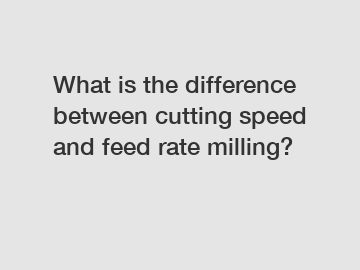What is the difference between cutting speed and feed rate milling?
What is the difference between cutting speed and feed rate milling?
When it comes to milling operations, understanding the difference between cutting speed and feed rate is crucial for achieving optimal results. Both factors play a significant role in determining the efficiency, accuracy, and productivity of milling processes. In this article, we will delve into the intricacies of these two parameters and discuss their impact on milling operations.
1. Cutting Speed:

Cutting speed refers to the speed at which the cutting tool rotates or moves relative to the workpiece during the milling process. It is typically measured in surface feet per minute (SFPM) or meters per minute (m/min). Cutting speed directly influences the amount of material removed from the workpiece per unit of time. Higher cutting speeds are generally associated with better productivity.
When it comes to cutting speed, factors such as material type, cutter type, and machine capability need to be considered. Different materials have different optimal cutting speeds, as each material has its own unique properties. Harder materials require lower cutting speeds, while softer materials can withstand higher cutting speeds. The type of cutter also affects cutting speed, as different cutters have different performance characteristics. Lastly, machine capability plays a crucial role in determining the maximum cutting speed that can be achieved.
2. Feed Rate:
Feed rate, on the other hand, refers to the distance that the cutting tool travels along the workpiece per revolution. It is typically measured in inches per minute (IPM) or millimeters per minute (mm/min). The feed rate determines the amount of material being removed from the workpiece per tooth of the cutter. It directly affects the surface finish, tool life, and overall machining time.
The feed rate is influenced by several factors, including the cutting tool geometry, material properties, and desired finish. Different cutting tools have different recommended feed rates, and exceeding these limits can result in poor surface finishes or tool breakage. Material properties, such as hardness and ductility, also affect the feed rate, as harder materials require slower feed rates to prevent excessive tool wear. The desired surface finish also plays a role, as achieving a finer finish usually requires lower feed rates.
3. Relationship between Cutting Speed and Feed Rate:
Cutting speed and feed rate are interrelated parameters that must be optimized to achieve efficient and accurate milling operations. The relationship between the two can be expressed using the following formula:
Cutting Speed (CS) = Feed Rate (FR) x Number of Teeth on Cutter (NT) x Chip Load Per Tooth (CL).
This formula highlights that cutting speed is influenced by both the feed rate and the number of teeth on the cutter. It also shows the importance of the chip load per tooth, which is the thickness of the material being removed by each cutting tooth. To maintain a constant chip load per tooth, a proportional adjustment between feed rate and cutting speed needs to be made.
4. Impact on Milling Process:
The choice of cutting speed and feed rate has a critical impact on the milling process. Setting an appropriate cutting speed ensures that the tool engages with the workpiece effectively, preventing excessive tool wear or damage. Conversely, selecting an optimal feed rate promotes chip evacuation, reduces tool deflection, and maintains surface finish. Balancing these two parameters is fundamental to achieving efficient material removal and minimizing machining time.
It is important to note that the ideal cutting speed and feed rate may vary based on the specific milling operation and the goals of machining. Different materials, cutter geometries, and machining strategies may require adjustments to maximize productivity and tool life.
In conclusion, understanding the difference between cutting speed and feed rate in milling is crucial for achieving optimal results. Cutting speed determines the rotary speed of the tool, while feed rate controls the distance the tool travels per revolution. By finding the right balance between these parameters, one can enhance productivity, accuracy, and surface finish in milling operations. Ultimately, a thorough understanding of cutting speed and feed rate enables machinists to unlock the full potential of milling processes.
Are you interested in learning more about coarse grinding hammer mill, powder mash precleaner, feed pellet grading machine? Contact us today to secure an expert consultation!


